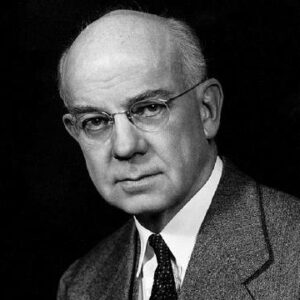Edward Calvin Kendall was an American chemist who specialized in adrenal gland hormones. He worked on adrenal gland research alongside Mayo Clinic physician Philip S. Hench, and their work earned them the Nobel Prize for Physiology or Medicine in 1950. Kendall was also responsible for the isolation of thyroxine, a hormone produced by the thyroid gland. He was born in Connecticut and attended Columbia University, where he got his Ph.D. in chemistry in 1910. He started his work at Parke, Davis, and Company, where he focused on thyroid hormone research. After years of research, he was able to isolate thyroxine, the thyroid gland’s active principle. He also conducted important research on adrenal gland hormones, isolating many steroids from the cortex of the adrenal gland, including the steroid hormone cortisone. It was for this achievement that he received worldwide renown and a share of the Nobel Prize in Physiology or Medicine. After several years as the Head of the Mayo Foundation’s Graduate School’s Biochemistry Section, he retired in 1951 and became a visiting professor of chemistry at Princeton University.
Childhood and Adolescence
Edward Calvin Kendall was born in the United States on March 8, 1886, to George Stanley Kendall and Eva Frances Abbott in South Norwalk, Connecticut.
After completing his education, he attended Columbia University for further study. He graduated with a Bachelor of Science in 1908 and a Master of Science in Chemistry the following year. With a dissertation on the kinetics of pancreatic amylase, he earned his Ph.D. in 1910.
The Career of Edward
In 1910, he started working as a chemist at Parke, Davis, and Company, where he worked on thyroid extracts. He was given the responsibility of isolating the hormone that is linked to the thyroid gland.
In 1911, he relocated to St. Luke’s Hospital in New York City’s new chemical pathology laboratory, where he continued his study. However, he did not enjoy working there since he thought that his research on thyroid extracts was undervalued in the context of clinical medicine. As a result, in 1913, he departed the laboratory.
In 1914, he was named Head of the Biochemistry Section at the Mayo Foundation’s Graduate School in Rochester, which gave him a boost in his career. He was promoted to Director of the Division of Biochemistry the following year, and then to Professor of Physiological Chemistry. He worked with the foundation until 1951 when he retired.
At the Mayo Foundation, his study on thyroid extracts had positive results, leading to the first extraction of crystalline thyroxine. In addition, he crystallized glutathione and determined its chemical composition, a molecule vital in biological oxidation-reduction reactions.
In the 1930s, Edward Calvin Kendall became interested in studies on the hormones of the adrenal gland. Dr. Philip Hench, who worked at the Mayo Foundation at the time, was also researching adrenal extracts. In a separate environment, Swiss chemist Reichstein was also working on the same topic.
Kendall and Hench contributed to the separation of the steroid hormone cortisone and its use in the treatment of rheumatoid arthritis after years of intensive research. Kendall and Hench, as well as Reichstein, were awarded the Nobel Prize for this achievement in 1950.
Kendall left Mayo in 1951 to become a visiting lecturer at Princeton University’s Department of Biochemistry. He remained a member of the Princeton community until his death in 1972.
Edward’s Major Projects
Edward Calvin Kendall is most known for isolating thyroxine, the thyroid hormone’s active component. He was also part of a team that crystallized glutathione, a molecule that plays a key role in cellular oxidation-reduction events.
In the 1930s, he studied the hormones produced by the adrenal cortex, and how extracts of these hormones may be utilized to treat the symptoms of various disorders. He discovered, in collaboration with Hench, that cortisone, one of the adrenal cortex’s hormones, has anti-inflammatory qualities and could be utilized to alleviate the symptoms of rheumatoid arthritis.
Achievements & Awards
“For research of adrenal hormones, culminating in the first use of cortisone in severe rheumatoid arthritis and other severe inflammatory illnesses,” Kendall and Hench shared the 1949 Albert Lasker Clinical Medical Research Award.
The Nobel Prize in Physiology or Medicine was awarded to Edward Calvin Kendall, Philip Showalter Hench, and Tadeusz Reichstein in 1950 “for their discoveries relative to the hormones of the adrenal cortex, their structure, and biological effects.”
Kendall and Hench earned the Passano Award from the San Francisco-based Passano Foundation in 1950 for their work on cortisone.
Personal History and Legacy
In 1915, Edward Calvin Kendall married Rebecca Kennedy, and the couple had four children together.
At the age of 86, he died on May 4, 1972.
Estimated Net worth
The estimated net worth of Edward Calvin Kendal is unknown.


